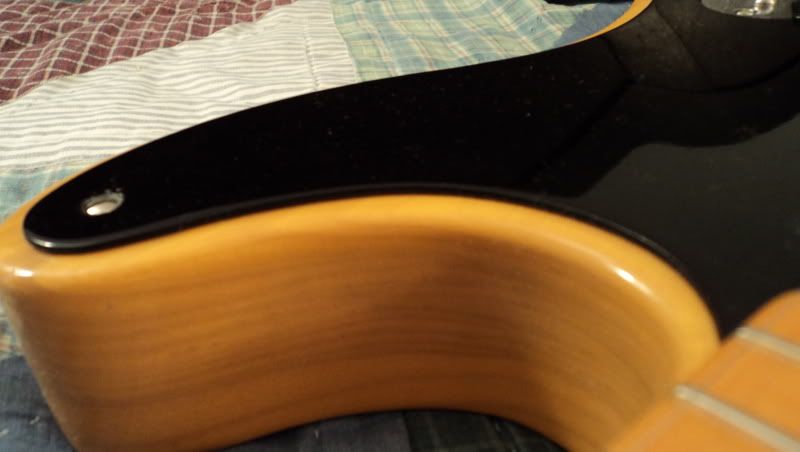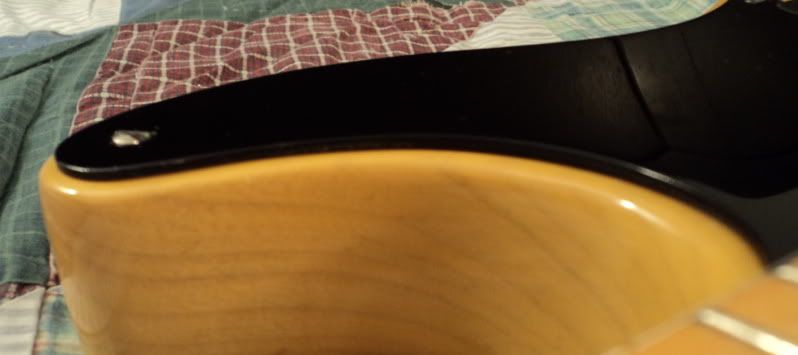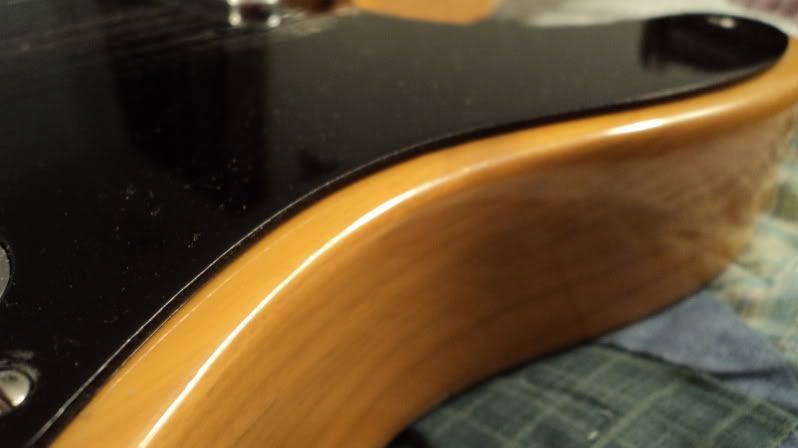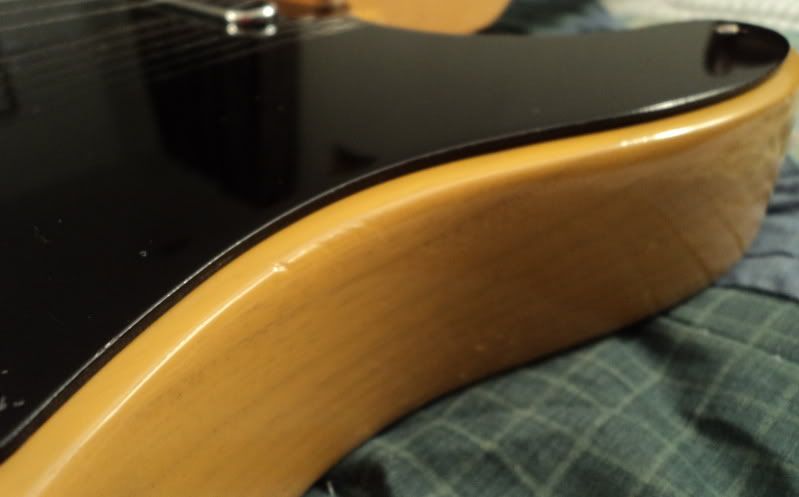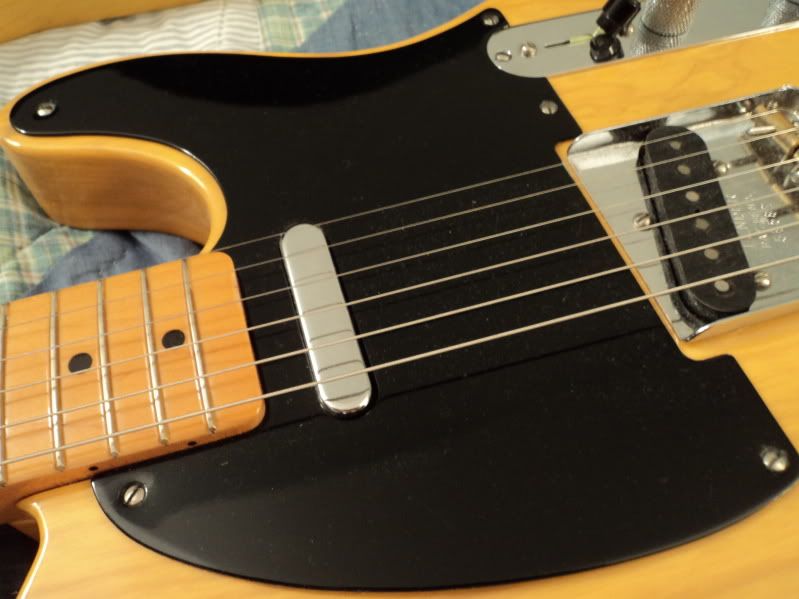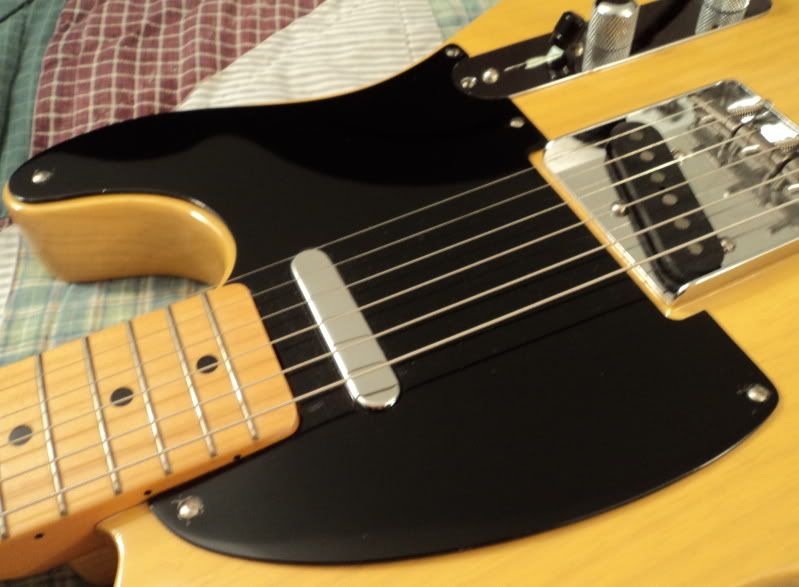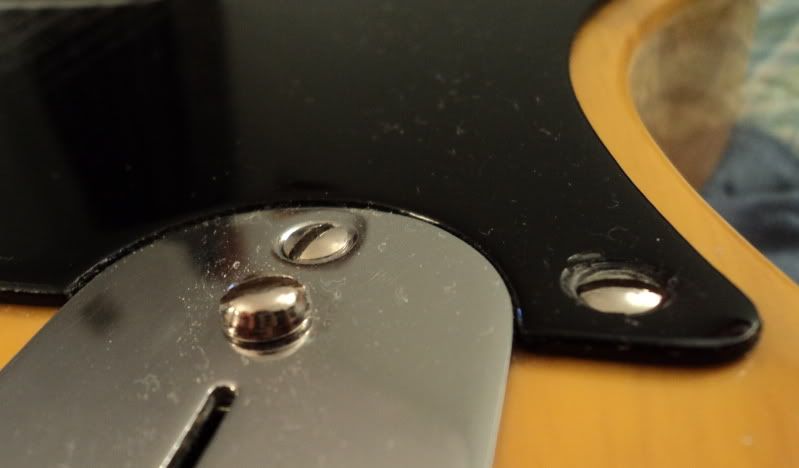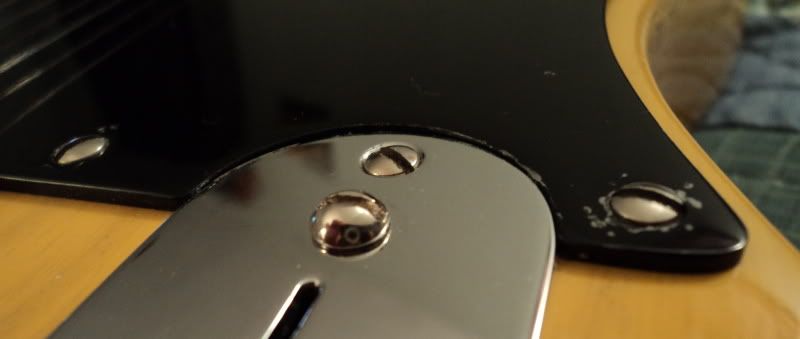angry tele
L'effet c'est moi
first a before pic.
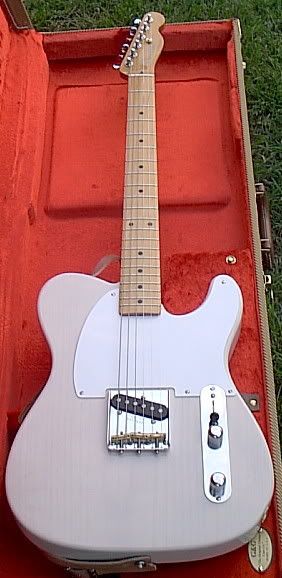
nothing wrong with this CIJ Poly
finish but I wanted blonde and nitro
so I sanded it down to bare wood
by hand, and went at it with verve.
the result are below...
mind you, this was my very first refinish I did several years ago.
it has held up remarkably well
with only a few dings and chips
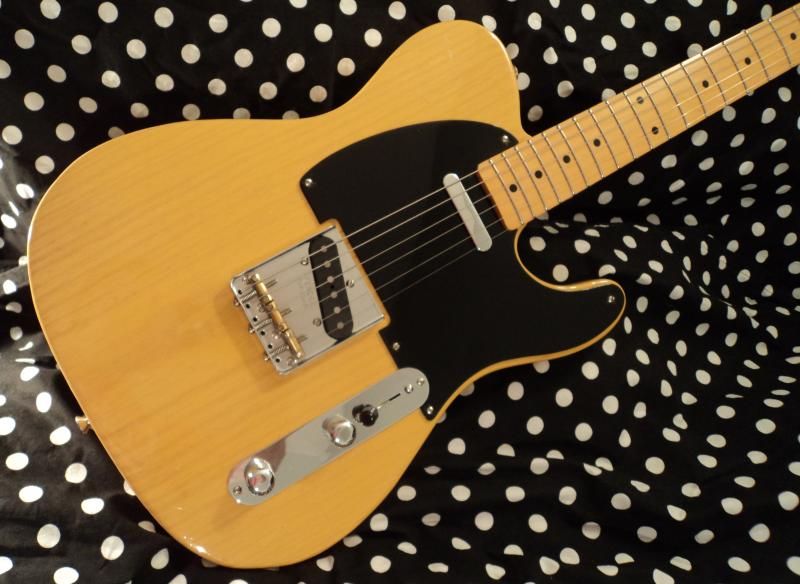
here you can see how shiny I got the flat-black bakelite guard.
all I did was sand with 600
shoot 2 lite coats of Minwax clear
buffed it out with Rubbing Compound
and finally Finish compound using
a synthetic wool cloth and elbo grease
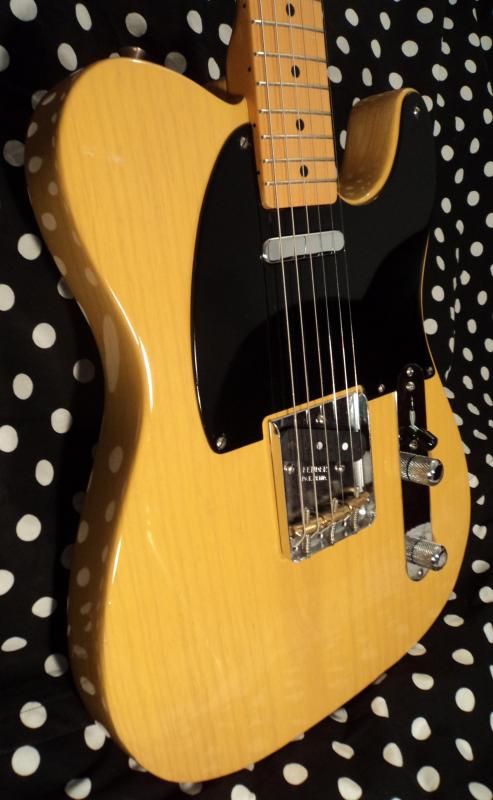
here she be mounting my 52RI.
note the color is less orange-pumpkin
more yellow like a 51 Nocaster
In my humble opinion mine looks better.

Im very pleased, dare I say proud of how this came out, but more important
I think this goes to show anyone can get a really good looking finish
using rattle cans and a little know-how.
Share your pics the good bad and the ugly, and lets see if we can encourage people
to tackle a project like this. I read on many forums a lot of nay-sayers saying
a rat-can finish will always lack a pro appearance but with patience, good products,
and a little know-how anyone can do this. Again this was my very first attemp at
painting anything and It came out damn near flawless.
a few tips/things I learned that may help
1. choose a guitar that plays and sounds great already.
rationale: going from poly to nitro will not make your
lifeless dead piece of wood magically turn into a tone monster.
also this is a lot of work and takes a lot of time-make sure the guitar
you molest is worth it. (if you're a consummate flipper don't bother-it will
not increase its value for resale, most likely the opposite will happen.
If you're doing it for yourself then you are doing it for the right reason.
2. Prep Prep Prep. I cannot stress enough how wood preperation is 90%
of a good final product. Without going into detail sand to 400-600 before
you begin the finish process. Sand with the grain as much as possible.
As much as you can work with sunlight or really good photographer quality
lights. Rationale: every scratch, dent, gouge etc; will end up being seen when all
is said and done. The reason is the finish and specifically the clear coat acts as a magnifiying
glass so that scratch you can barely resolve naked will stick out like a turd in a punch bowl
after its all finished. You dont want that. To avoid this like I said work in natural light
as much as possible, use natural light-bulbs if that's an option, go over the guitar many times
with a magnifying glass or photog loop. It also helps to take good pictures. Some things
the naked cant pickup that a picture will.
3. When (if) using grain filler take your time and make sure the grains are properly filled
to within 90% or so. Do not think, "oh those holes will be filled with all the color/clear/sanding sealer
so Im just going to ignore them WRONG! those holes will haunt your existence if you dont get them now.
4. Use sanding sealer. This is a must unless you are a pro and/or really know what you're doing,
and lets face it if you're taking advice from me you don't so use it. Rationale: SS is a high-molecular
weight finish that enables one to get a perfectly flat surface to paint on. Why does it have to be perfectly flat? I dunno it just does. If its not flat it will not be a shiny finish at the end. To use properly spray enough
SS to give the guitar a nice coat, then repeat a few times. Let dry and carefully sand to 400-600
for a nice flat surface.
5. Color coat and/or primer. From here until the end you will be doing no more sanding
so your spray technique must be on point. (no runs, too close, too far away) Rationale:
Nitro is very user friendly. all coats will meld into each other. you can spray the sides and ends one day
and the top/bottom the next. as long as you remember the areas you missed you should be ok getting an even coat. This is where spraying in good light whether natural or indoor lighting helps-if you
cant see what the fuck youre spraying you may be SOL in the end. Don't worry too much about
peau d'orange at this point when final buffing it will disappear.
6. Clear coat. Do not be afraid to spray a lot of clear. Rationale: clear coat will act as a buffer
between your sausage finger heavy hands and reduce the risk of sand-throughs. I shot 5 cans of clear before I was done (more on this later)
7. Patience young grasshopper. You are nearly done but you must now wait 1-3 months before
final wet sanding and buffing. Yes this is as much fun as wiping your butt with pinecones,
but it is crucial. Rationale: If you final sand and buff too soon you risk the finish crapping out
on you and having to start all over again. Fuck that. Just wait. I put my body hanging in a closet
with a small fan blowing in its general direction. Rationale: Nitro, the volatile, nasty shit that it is
needs time to gass-off. Give it time or it will bend you over.
8. wet sand/final buff. Yay you are almost there! I use baby-oil but you can use plain water. The oil/water keeps the paper from clogging up and increases its lifespan dramatically. Wet-sand until you have all the high spots gone. You will be able to see these high spots easily. Once gone its time to buff it out. Its also a good idea to stuff any hole with cotton or wax, this helps keep moisture from getting down
those holes which will expand the wood-not good times. (with baby oil there is less of a problem with this)
a good regiment is to sand 800>1000>1200>2000
9. Rubbing compound/Finish Compound. Use a synthetic wool cloth and liberal amounts of rubbing compound first and then finish compound next. Rationale: Both rubbing and finish compounds are nothing more than liquid sandpaper. Just put a big glob on the guitar, take the cloth and rub that shit in.
thats about it.
some specific tips:
-shake the rattle can for 1 full minute before spraying. and spray a few shots into the air to make sure the can is not spitting. These cans have lacquer thinner in them and if not mixed properly they will spit
that shit all over your nearly finished guitar-you dont want that. trust me.
-keep the cans warm. Cold cans dont mix well and will spit on your face of the guitar.
-only spray when the humidity is under 55% Rationale water molecules in the air will end up in your finish cuaseing haze or blushing that looks like crap and must be fixed with a blush remover. Just avoid all that by only spraying when the weather is right (this goes back to patience)
-only use about 3/4ths of a can. When a rattle can gets low it likes to spit and sputter all over you and your guitar. When it gets low, toss it.
-use the rule of 3s: 3 passes is 1 coat, shoot no more than 3 coats per day, 3 hours apart, no more than 3 days in a row.
the nitro needs time to gass off, the more time you give it while painting, the less time you will have to wait later.
-occasionally between coats after they are dry wipe it all down with naptha. You want to get rid of any oils from your cheeto fingers or natural oils from your butt picking.
-light colors are a lot easier to get perfect. Dark colors show every dust particle (dust hitch rides on ray of light (no shit), wind, bee-eyelashes etc; Anything that lands on the finish will be there forever. Thast why its best to shoot in a well ventilated, preferably reverse-air pressure spray room. And make sure you wear an air rebreather mask with a filter. Nitro is nasty shit that can give you kidney cancer and kids with extra chromosomes-you dont want that. I shot in a ghetto-spray booth which was some plastic tarp draped over a big latter. It worked but if doing black or any dark color i would have been screwed.
Mainly have fun, relax, and take your time. This is supposed to be fun!
this is just stuff I learned along the way and techniques I used; I am in no way an expert. Hopefully experts will chime in with more advice and make corrections where needed.
But if you follow this advice you should be able to get pretty damn good results.

nothing wrong with this CIJ Poly
finish but I wanted blonde and nitro
so I sanded it down to bare wood
by hand, and went at it with verve.
the result are below...
mind you, this was my very first refinish I did several years ago.
it has held up remarkably well
with only a few dings and chips

here you can see how shiny I got the flat-black bakelite guard.
all I did was sand with 600
shoot 2 lite coats of Minwax clear
buffed it out with Rubbing Compound
and finally Finish compound using
a synthetic wool cloth and elbo grease

here she be mounting my 52RI.
note the color is less orange-pumpkin
more yellow like a 51 Nocaster
In my humble opinion mine looks better.

Im very pleased, dare I say proud of how this came out, but more important
I think this goes to show anyone can get a really good looking finish
using rattle cans and a little know-how.
Share your pics the good bad and the ugly, and lets see if we can encourage people
to tackle a project like this. I read on many forums a lot of nay-sayers saying
a rat-can finish will always lack a pro appearance but with patience, good products,
and a little know-how anyone can do this. Again this was my very first attemp at
painting anything and It came out damn near flawless.
a few tips/things I learned that may help
1. choose a guitar that plays and sounds great already.
rationale: going from poly to nitro will not make your
lifeless dead piece of wood magically turn into a tone monster.
also this is a lot of work and takes a lot of time-make sure the guitar
you molest is worth it. (if you're a consummate flipper don't bother-it will
not increase its value for resale, most likely the opposite will happen.
If you're doing it for yourself then you are doing it for the right reason.
2. Prep Prep Prep. I cannot stress enough how wood preperation is 90%
of a good final product. Without going into detail sand to 400-600 before
you begin the finish process. Sand with the grain as much as possible.
As much as you can work with sunlight or really good photographer quality
lights. Rationale: every scratch, dent, gouge etc; will end up being seen when all
is said and done. The reason is the finish and specifically the clear coat acts as a magnifiying
glass so that scratch you can barely resolve naked will stick out like a turd in a punch bowl
after its all finished. You dont want that. To avoid this like I said work in natural light
as much as possible, use natural light-bulbs if that's an option, go over the guitar many times
with a magnifying glass or photog loop. It also helps to take good pictures. Some things
the naked cant pickup that a picture will.
3. When (if) using grain filler take your time and make sure the grains are properly filled
to within 90% or so. Do not think, "oh those holes will be filled with all the color/clear/sanding sealer
so Im just going to ignore them WRONG! those holes will haunt your existence if you dont get them now.
4. Use sanding sealer. This is a must unless you are a pro and/or really know what you're doing,
and lets face it if you're taking advice from me you don't so use it. Rationale: SS is a high-molecular
weight finish that enables one to get a perfectly flat surface to paint on. Why does it have to be perfectly flat? I dunno it just does. If its not flat it will not be a shiny finish at the end. To use properly spray enough
SS to give the guitar a nice coat, then repeat a few times. Let dry and carefully sand to 400-600
for a nice flat surface.
5. Color coat and/or primer. From here until the end you will be doing no more sanding
so your spray technique must be on point. (no runs, too close, too far away) Rationale:
Nitro is very user friendly. all coats will meld into each other. you can spray the sides and ends one day
and the top/bottom the next. as long as you remember the areas you missed you should be ok getting an even coat. This is where spraying in good light whether natural or indoor lighting helps-if you
cant see what the fuck youre spraying you may be SOL in the end. Don't worry too much about
peau d'orange at this point when final buffing it will disappear.
6. Clear coat. Do not be afraid to spray a lot of clear. Rationale: clear coat will act as a buffer
between your sausage finger heavy hands and reduce the risk of sand-throughs. I shot 5 cans of clear before I was done (more on this later)
7. Patience young grasshopper. You are nearly done but you must now wait 1-3 months before
final wet sanding and buffing. Yes this is as much fun as wiping your butt with pinecones,
but it is crucial. Rationale: If you final sand and buff too soon you risk the finish crapping out
on you and having to start all over again. Fuck that. Just wait. I put my body hanging in a closet
with a small fan blowing in its general direction. Rationale: Nitro, the volatile, nasty shit that it is
needs time to gass-off. Give it time or it will bend you over.
8. wet sand/final buff. Yay you are almost there! I use baby-oil but you can use plain water. The oil/water keeps the paper from clogging up and increases its lifespan dramatically. Wet-sand until you have all the high spots gone. You will be able to see these high spots easily. Once gone its time to buff it out. Its also a good idea to stuff any hole with cotton or wax, this helps keep moisture from getting down
those holes which will expand the wood-not good times. (with baby oil there is less of a problem with this)
a good regiment is to sand 800>1000>1200>2000
9. Rubbing compound/Finish Compound. Use a synthetic wool cloth and liberal amounts of rubbing compound first and then finish compound next. Rationale: Both rubbing and finish compounds are nothing more than liquid sandpaper. Just put a big glob on the guitar, take the cloth and rub that shit in.
thats about it.
some specific tips:
-shake the rattle can for 1 full minute before spraying. and spray a few shots into the air to make sure the can is not spitting. These cans have lacquer thinner in them and if not mixed properly they will spit
that shit all over your nearly finished guitar-you dont want that. trust me.
-keep the cans warm. Cold cans dont mix well and will spit on your face of the guitar.
-only spray when the humidity is under 55% Rationale water molecules in the air will end up in your finish cuaseing haze or blushing that looks like crap and must be fixed with a blush remover. Just avoid all that by only spraying when the weather is right (this goes back to patience)
-only use about 3/4ths of a can. When a rattle can gets low it likes to spit and sputter all over you and your guitar. When it gets low, toss it.
-use the rule of 3s: 3 passes is 1 coat, shoot no more than 3 coats per day, 3 hours apart, no more than 3 days in a row.
the nitro needs time to gass off, the more time you give it while painting, the less time you will have to wait later.
-occasionally between coats after they are dry wipe it all down with naptha. You want to get rid of any oils from your cheeto fingers or natural oils from your butt picking.
-light colors are a lot easier to get perfect. Dark colors show every dust particle (dust hitch rides on ray of light (no shit), wind, bee-eyelashes etc; Anything that lands on the finish will be there forever. Thast why its best to shoot in a well ventilated, preferably reverse-air pressure spray room. And make sure you wear an air rebreather mask with a filter. Nitro is nasty shit that can give you kidney cancer and kids with extra chromosomes-you dont want that. I shot in a ghetto-spray booth which was some plastic tarp draped over a big latter. It worked but if doing black or any dark color i would have been screwed.
Mainly have fun, relax, and take your time. This is supposed to be fun!
this is just stuff I learned along the way and techniques I used; I am in no way an expert. Hopefully experts will chime in with more advice and make corrections where needed.
But if you follow this advice you should be able to get pretty damn good results.
Last edited:


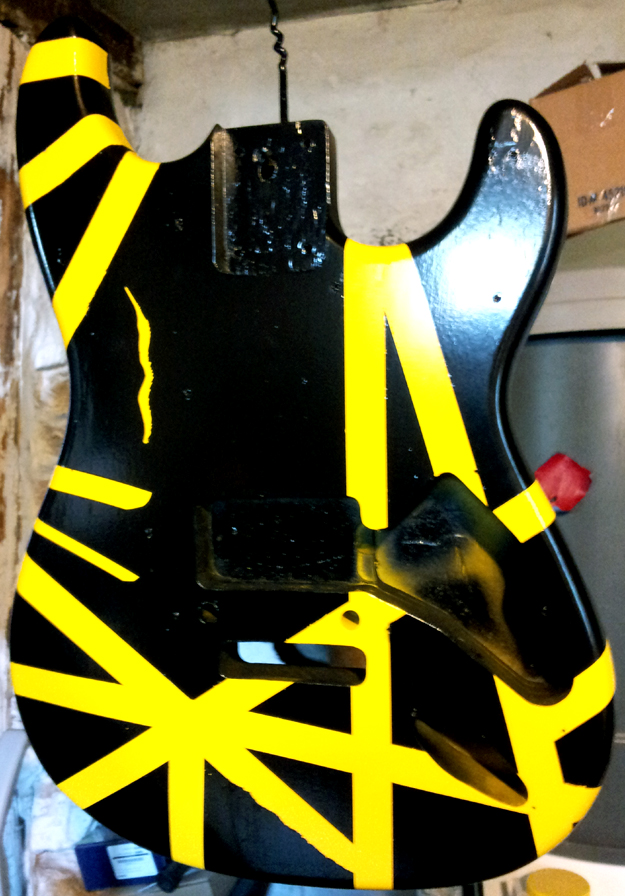

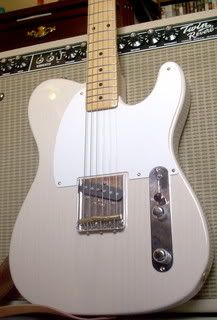



 I generally only buy the primer, color, and the tinted clear (if I'm going for that look) from ReRanch. I like the Minwax clear, both because it's cheaper and they use a great spray nozzle that makes it pretty easy to get a uniform coat.
I generally only buy the primer, color, and the tinted clear (if I'm going for that look) from ReRanch. I like the Minwax clear, both because it's cheaper and they use a great spray nozzle that makes it pretty easy to get a uniform coat.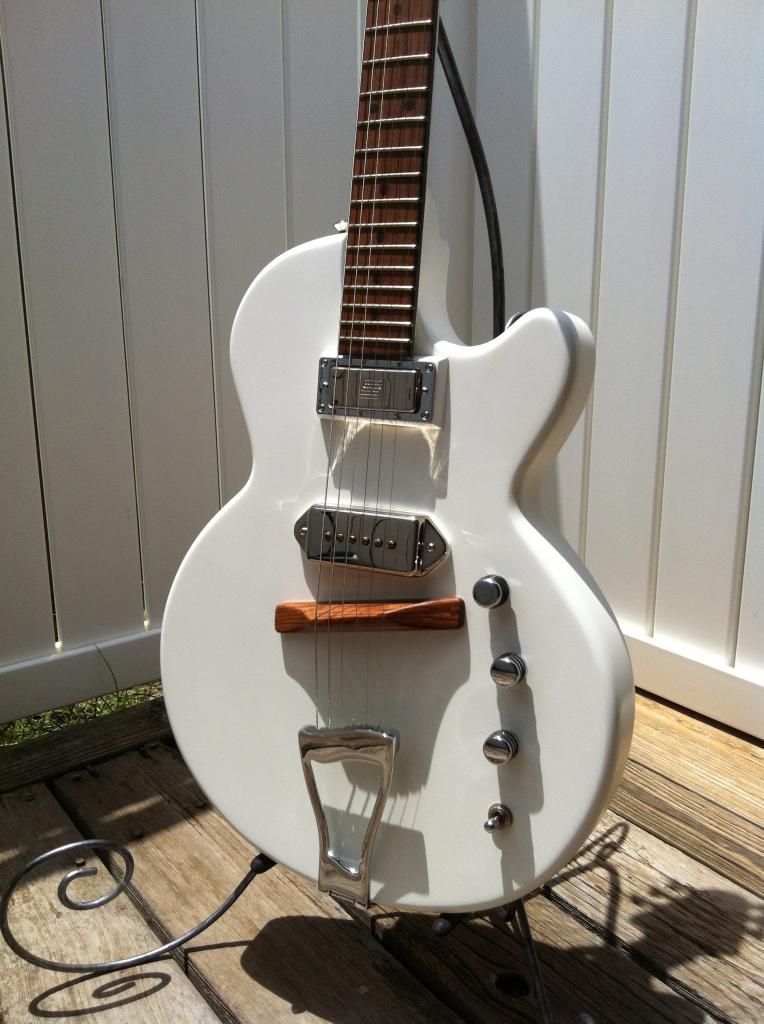

 the surf green tele!!!!
the surf green tele!!!!
